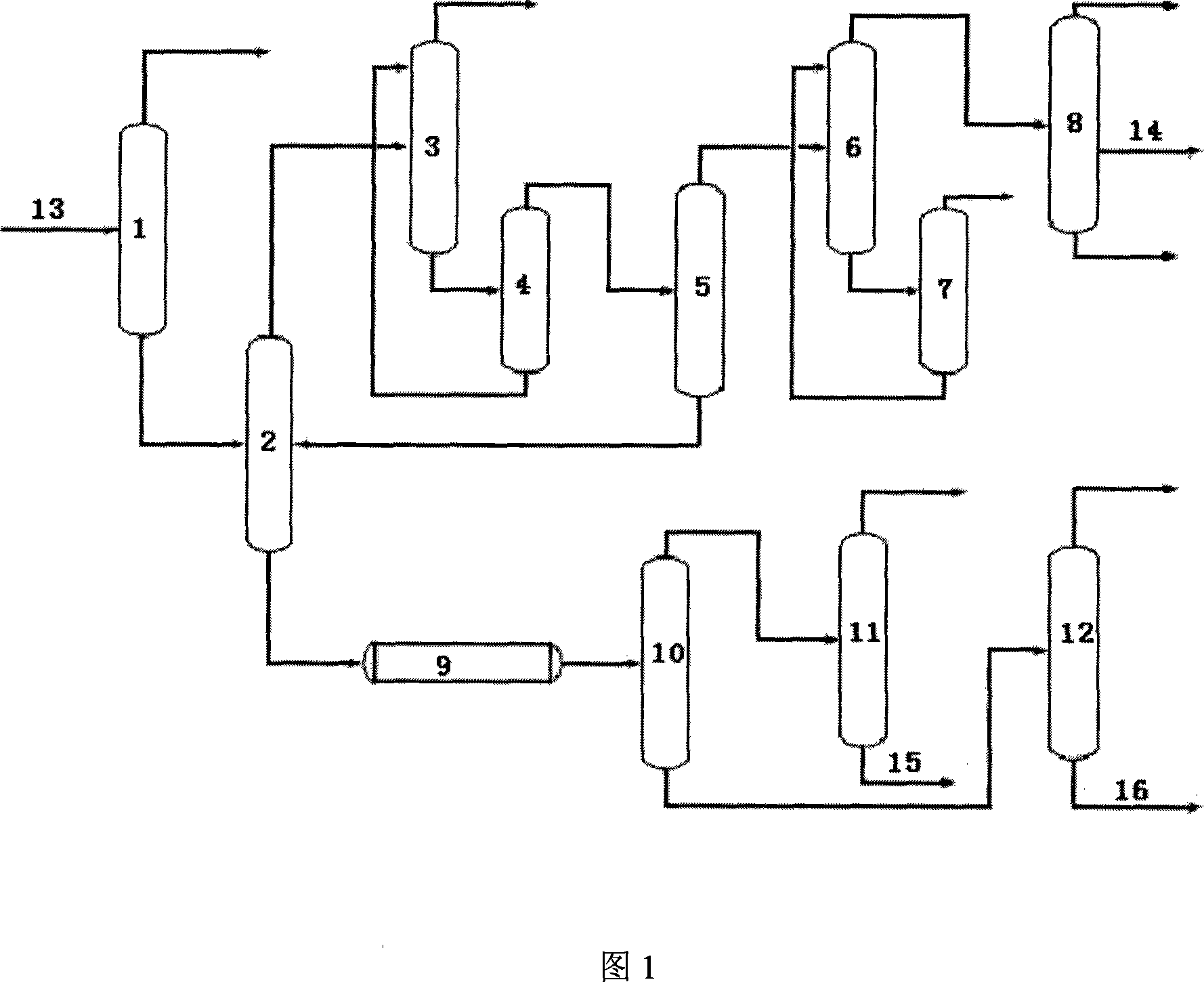Separation method of diene hydrocarbon in five fractions of petroleum cracked carbon
A C5 fraction and petroleum cracking technology, applied in hydrocarbon purification/separation, distillation purification/separation, chemical instruments and methods, etc., can solve the loss of isoprene and cyclopentadiene, the purity of dicyclopentadiene products Low cost, low utilization value and other problems, to achieve the effect of improving conversion rate, avoiding self-polymerization and copolymerization loss, and low operating cost
- Summary
- Abstract
- Description
- Claims
- Application Information
AI Technical Summary
Problems solved by technology
Method used
Image
Examples
Embodiment 1
[0047] According to the technological process shown in Fig. 1, the C5 fraction 13 of raw petroleum cracking enters the middle part of the isoprene separation tower 2 from the 55th tray, and the stream I rich in isoprene is obtained by separation at the top of the tower, and the stream I rich in isoprene is obtained by separation at the bottom of the tower. Stream II of cyclopentadiene and piperylene. The feed temperature of isoprene separation tower 1 is 50°C, the number of trays is 110, the temperature of the tower bottom is 79°C, the temperature of the top of the tower is 52°C, the pressure of the top of the tower is 0.09MPa, the pressure of the bottom of the tower is 0.17MPa, and the reflux The ratio is 11. The polymerization inhibitor is diethylhydroxylamine.
[0048] Stream I enters the 80th tray in the middle part of the first extractive distillation tower 3, contacts with the dimethylformamide solvent entering from the 6th tray of the tower for extractive distillation,...
Embodiment 2
[0070] According to the technical process of [Example 1], just before the C5 fraction of raw material cracking enters the isoprene separation tower 2, it enters from the 44th tray in the middle part of the light removal tower 1, and rectification separation is carried out, and the top of the tower is removed C4 and components below C4, the C5 stream XI in the tower kettle enters the middle part of the isoprene separation tower 2 . Light removal tower 1 has 75 plates, feed temperature is 50°C, tower bottom temperature is 76°C, tower top temperature is 49°C, tower top pressure is 0.15MPa, tower bottom pressure is 0.20MPa, and reflux ratio is 20 . The polymerization inhibitor ortho-nitrophenol enters the tower together with the C5 raw material.
[0071] The solvent A in the first extractive distillation column and the solvent B in the second extractive distillation column are acetonitrile, and the polymerization inhibitor is nitrogen methyl pyrrolidone; The polymerization inhibi...
Embodiment 3
[0091] According to the technical process of [Example 2], only the solvent A in the first extractive distillation column is dimethylacetamide, and the polymerization inhibitor is a composite polymerization inhibitor of sodium nitrite and ethanolamine, wherein the quality of sodium nitrite and ethanolamine The ratio is 10:1, and the carbon pentayl concentration of ethanolamine is 160 ppm. The solvent B in the second extractive distillation tower is nitrogen methyl pyrrolidone, the polymerization inhibitor is nitrobenzene, and the polymerization inhibitor in the separation process of other solvent-free existence is tert-butyl quinone.
[0092] The purity of piperylene was 68.99%, and the purity of dicyclopentadiene was 90.32%.
[0093] The operating conditions of each unit are shown in Table 4, and the weight percentage composition of raw materials and components of each unit is shown in Table 5.
[0094] Table 4
[0095] operating conditions
Light removal tower 1...
PUM
 Login to View More
Login to View More Abstract
Description
Claims
Application Information
 Login to View More
Login to View More - R&D
- Intellectual Property
- Life Sciences
- Materials
- Tech Scout
- Unparalleled Data Quality
- Higher Quality Content
- 60% Fewer Hallucinations
Browse by: Latest US Patents, China's latest patents, Technical Efficacy Thesaurus, Application Domain, Technology Topic, Popular Technical Reports.
© 2025 PatSnap. All rights reserved.Legal|Privacy policy|Modern Slavery Act Transparency Statement|Sitemap|About US| Contact US: help@patsnap.com

